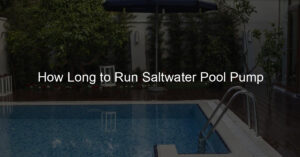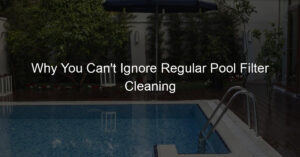Introduction to Pool Maintenance
Having a swimming pool is a great way to cool off during hot summer days. However, owning a pool also comes with responsibilities. One of these is pool maintenance. In this section, we will discuss the importance of regular pool maintenance and understanding your pool’s chemical balance.
- The Importance of Regular Pool Maintenance
- Understanding Your Pool’s Chemical Balance
Regular pool maintenance is crucial for several reasons. First, it ensures that your pool is safe to use. A poorly maintained pool can harbor harmful bacteria and other microorganisms, which can cause health problems. Second, regular maintenance can help you avoid costly repairs in the future. For example, if you neglect to clean your pool regularly, it can lead to problems like algae growth and water discoloration. These issues can be expensive to fix.
Understanding your pool’s chemical balance is another essential aspect of pool maintenance. The chemical balance of your pool refers to the levels of different chemicals in your pool water. These include chlorine, which is used to kill bacteria and other harmful organisms, and pH, which measures how acidic or basic your pool water is.
Keeping these chemicals at the right levels is important for several reasons. For one, it helps ensure that your pool is safe to swim in. If your pool’s chemical balance is off, it can cause problems like skin irritation and eye discomfort. Moreover, a proper chemical balance helps keep your pool water clear and sparkling, making your swimming experience more enjoyable.
In the following sections, we will delve deeper into the specifics of pool maintenance, including how to use pool test kits, maintain your pool’s chemical balance, and ensure your pool water’s quality. By the end of this guide, you will have a solid understanding of how to keep your pool clean, safe, and enjoyable for everyone.
Understanding Pool Test Kits
Keeping your swimming pool clean and safe is a top priority. One of the essential tools in achieving this is a pool test kit. Let’s dive into understanding what a pool test kit is and how it works.
What is a Pool Test Kit?
A pool test kit is a handy tool that helps you monitor the chemical balance of your swimming pool water. It’s like a health check-up for your pool.
- Definition and Purpose of Pool Test Kits
- Pool Test Kit Instructions: How They Work
- Fill the test kit’s vial with pool water.
- Add the appropriate testing reagent or dip the test strip into the water.
- Compare the color of the water or test strip with the color chart provided.
- Read the results and adjust your pool chemicals as needed.
A pool test kit is a set of chemicals and color scales used to test the water in your swimming pool. The purpose of a pool test kit is to measure the levels of different chemicals in the pool water. These include chlorine, bromine, pH, total alkalinity, and calcium hardness. By keeping these levels in check, you can ensure your pool is safe and enjoyable to swim in.
Using a pool test kit is quite simple. Here’s a basic step-by-step guide:
Remember, each pool test kit might have slightly different instructions, so always read the manual that comes with your kit.
Understanding and using a pool test kit is a crucial part of maintaining a healthy and clean pool. By regularly testing your pool water, you can prevent problems before they happen and enjoy a refreshing swim anytime you want.
Types of Pool Test Kits
There are several types of pool test kits available in the market. Each type has its own unique features and benefits. Let’s explore them in detail:
- Reagent Test Kits
- Test Strips
- Digital Testers
- Pool Test Kit Comparison: Which One is Right for You?
Reagent test kits are one of the most accurate types of pool testing kits. They use chemicals called reagents to react with the water and change its color. The color change is then compared to a color chart to determine the levels of different chemicals in the pool. These kits usually test for chlorine, pH, and alkalinity levels.
Test strips are a simple and quick way to test your pool water. You just need to dip a strip into the water, and it will change color based on the chemical levels. The strip is then compared to a color chart to determine the levels. These strips can test for several chemicals at once, including chlorine, bromine, pH, alkalinity, and hardness.
Digital testers are the most advanced type of pool test kits. They use electronic sensors to measure the chemical levels in the pool water. These testers provide a digital readout, eliminating the need to compare colors or interpret results. They are highly accurate and easy to use, but they are also the most expensive option.
Choosing the right pool test kit depends on your specific needs and budget. If you want the most accurate results and don’t mind spending a bit more, a reagent kit or a digital tester might be the best choice. On the other hand, if you prefer a quick and easy testing method, test strips might be more suitable. Remember, maintaining a balanced pool is crucial for your health and the longevity of your pool.
Using Swimming Pool Test Kits
Keeping your swimming pool clean and healthy requires regular testing. This process can seem daunting, but with the right tools and a bit of knowledge, it’s quite simple. Here’s a step-by-step guide to using swimming pool test kits.
Step-by-Step Guide to Pool Water Testing
Testing your pool water involves three main steps: collecting the water sample, applying the test reagents or strips, and reading the results. Let’s break down each step.
- Collecting the Water Sample
- Applying the Test Reagents or Strips
- Reading the Results
The first step in testing your pool water is to collect a sample. To do this, reach down about 18 inches into the pool – not too close to the sides or the return jets – and fill your test kit’s vial. This depth is ideal because it gives a more accurate representation of the overall pool water.
Once you have your water sample, it’s time to apply the test reagents or strips. If you’re using a liquid test kit, add the indicated number of drops of each reagent to the vial. If you’re using test strips, simply dip the strip into the water sample for the amount of time specified on the package.
After applying the test reagents or strips, you’ll need to read the results. For a liquid test kit, compare the color of the water in the vial to the color chart included with the kit. For test strips, compare the color of the pads on the strip to the color chart on the package. These colors will tell you the levels of different chemicals in your pool water.
By following these steps, you can ensure that your pool water is safe and clean. Regular testing is key to maintaining a healthy swimming pool. Remember, it’s not just about keeping the water clear; it’s about ensuring the water is balanced and safe for everyone to enjoy.
Interpreting Your Pool Water Testing Results
Once you’ve conducted your pool water tests, it’s essential to understand what the results mean. Let’s break down the key components: chlorine, pH, and alkalinity levels.
-
Understanding Pool Chlorine Levels
Chlorine is a crucial component in pool water as it acts as a disinfectant, killing harmful bacteria and algae. The ideal chlorine level for your pool should be between 1.0 and 3.0 parts per million (ppm).
If your chlorine levels are too low, your pool may become a breeding ground for bacteria and algae. On the other hand, if the levels are too high, it can cause skin and eye irritation. Regular testing and adjustment of your pool’s chlorine levels will ensure a safe and enjoyable swimming experience.
-
Deciphering Pool pH Levels
The pH level of your pool water indicates how acidic or basic it is. A pH level of 7 is neutral. The ideal pH level for pool water is slightly basic, between 7.2 and 7.8.
If your pool’s pH level is too low, it means your water is acidic. This can lead to corrosion of pool equipment and irritation of skin and eyes. If the pH level is too high, your pool water is basic or alkaline, which can cause cloudy water and reduce the effectiveness of chlorine.
-
Grasping Pool Alkalinity Testing Results
Alkalinity is a measure of the water’s ability to neutralize acids. It acts as a pH buffer, preventing sudden pH changes. The recommended alkalinity level for pool water is between 80 and 120 ppm.
Low alkalinity can cause pH levels to fluctuate wildly, leading to pool water instability. High alkalinity, on the other hand, can cause the pH level to rise too high, leading to cloudy water and scale formation.
Understanding your pool water testing results is key to maintaining a healthy, clean pool. Regular testing and adjustment of these three components will ensure a safe and enjoyable swimming environment.
Maintaining Your Pool’s Chemical Balance
Keeping your pool’s chemical balance in check is crucial for the health and safety of those who use it. One of the key elements in this balance is chlorine. Let’s delve into how to adjust your pool’s chlorine levels effectively.
Adjusting Pool Chlorine Levels
Chlorine is a vital component in maintaining a clean and safe swimming pool. It helps keep the water free from harmful bacteria and algae. However, it’s essential to manage the chlorine levels correctly to ensure the water is safe for swimming.
- When and How to Add Chlorine
- Safe Chlorine Levels for Swimming
Chlorine should be added to your pool regularly, typically once a week. The best time to add chlorine is in the evening when the sun is down. This is because sunlight can break down chlorine, reducing its effectiveness. To add chlorine, you can use a chlorine dispenser or directly pour the chlorine into the pool, spreading it around to ensure it mixes well with the water.
The safe chlorine level for swimming is between 1.0 and 3.0 parts per million (ppm). If the chlorine level is below 1.0 ppm, it may not effectively kill bacteria and algae. On the other hand, if it’s above 3.0 ppm, it can cause skin and eye irritation. Therefore, it’s crucial to regularly test and adjust your pool’s chlorine levels to keep them within this range.
Remember, maintaining the right chlorine levels in your pool is a balance. Too little can lead to a dirty pool, while too much can be harmful to swimmers. Regular testing and adjustment can help ensure a clean and safe swimming environment.
Regulating Pool pH and Alkalinity Levels
Keeping your pool’s pH and alkalinity levels in check is crucial for maintaining a healthy and clean swimming environment. Let’s dive into how you can effectively manage these levels.
-
How to Raise or Lower pH Levels
The pH level of your pool water indicates how acidic or basic it is. The ideal pH level for a swimming pool is between 7.2 and 7.8. If the pH level is too low, the water becomes acidic, leading to skin irritation and damage to the pool equipment. On the other hand, if the pH level is too high, the water becomes basic, causing cloudy water and scale formation.
To raise the pH level, you can add a pH increaser, usually sodium carbonate. Start by adding a small amount, wait for a few hours, and then test the water. If the pH is still low, add more. To lower the pH level, you can use a pH reducer, typically sodium bisulfate. Again, add a small amount, wait, and then test the water. If the pH is still high, add more.
Remember, it’s important to make these adjustments gradually to avoid drastic changes in the water chemistry.
-
Managing Pool Alkalinity
Alkalinity is a measure of the water’s ability to neutralize acids. It acts as a pH buffer, preventing sudden pH swings. The recommended alkalinity level for a swimming pool is between 80 and 120 parts per million (ppm).
If the alkalinity is too low, the pH level can fluctuate widely, leading to water imbalance. To increase alkalinity, you can add an alkalinity increaser, usually sodium bicarbonate. Start by adding a small amount, wait for a few hours, and then test the water. If the alkalinity is still low, add more.
If the alkalinity is too high, it can cause the pH level to rise, leading to cloudy water and scale formation. To decrease alkalinity, you can add an alkalinity reducer, usually muriatic acid or sodium bisulfate. Again, add a small amount, wait, and then test the water. If the alkalinity is still high, add more.
Just like with pH, it’s important to adjust alkalinity levels gradually to maintain a balanced water chemistry.
By regularly testing and adjusting your pool’s pH and alkalinity levels, you can ensure a safe and enjoyable swimming experience for everyone. Remember, a well-maintained pool is a happy pool!
Swimming Pool Water Quality: Beyond Chemical Testing
While chemical testing is a crucial part of maintaining a swimming pool, it’s not the only factor that affects the water quality. Two other essential aspects are the filtration and circulation systems and regular cleaning. Let’s delve into these topics to understand their importance better.
-
The Role of Filtration and Circulation
The filtration system in your swimming pool plays a significant role in maintaining water quality. It removes debris, dirt, and other unwanted particles from the water, keeping it clean and clear. But did you know that the circulation system is just as important?
The circulation system moves the water around, ensuring that the chemicals are evenly distributed. This prevents the formation of ‘dead spots’ where algae and bacteria can grow. A well-functioning circulation system also helps the filtration system work more efficiently by spreading the water evenly through the filter.
According to a study by the Centers for Disease Control and Prevention (CDC), improper circulation and filtration can lead to various health issues, including ear infections and gastrointestinal illnesses. So, it’s clear that these two systems play a vital role in maintaining the quality of your swimming pool water.
-
Importance of Regular Cleaning
Regular cleaning is another crucial factor in maintaining the quality of your swimming pool water. This involves tasks like skimming the surface for leaves and other debris, brushing the walls and floor of the pool to prevent algae buildup, and vacuuming to remove any dirt that has settled on the bottom.
Regular cleaning not only keeps your pool looking great, but it also helps maintain the effectiveness of your chemicals and filtration system. For example, if there’s a lot of debris in the pool, the chemicals will be used up more quickly, and the filter will have to work harder.
According to the National Swimming Pool Foundation, regular cleaning can reduce the need for chemicals by up to 60%. So, not only does it improve the quality of your pool water, but it can also save you money in the long run.
In conclusion, while chemical testing is important, it’s not the only factor that affects the quality of your swimming pool water. By understanding the role of filtration and circulation and the importance of regular cleaning, you can ensure that your pool is always clean, safe, and ready for use.
Pool Maintenance Tips for a Healthy, Clean Pool
Keeping your pool clean and healthy is not as daunting as it might seem. With a few simple steps and regular maintenance, you can ensure your pool is always ready for a refreshing dip. Here are three key tips to help you maintain a healthy, clean pool.
- Regular Testing and Adjustment
- Seasonal Pool Care
- Professional Pool Maintenance: When to Call the Experts
Regular testing of your pool’s water is crucial in maintaining its health and cleanliness. This involves checking the pH, chlorine, and alkalinity levels. Ideally, the pH level should be between 7.2 and 7.8, while the chlorine level should be between 1.0 and 3.0 parts per million. If these levels are off, you’ll need to adjust them using pool chemicals. Remember, always add chemicals to water, not the other way around, to prevent dangerous reactions.
Seasonal pool care is another important aspect of pool maintenance. In the summer, when the pool is frequently used, it’s important to skim off leaves and debris every day. In the winter, you should cover your pool to protect it from the elements. In the spring, it’s time to prepare your pool for the swimming season by cleaning it thoroughly and adjusting the water chemistry.
While regular testing and seasonal care can keep your pool in good shape, there are times when you might need to call in the experts. If your pool has persistent algae problems, if the water is cloudy or has a strange color, or if the pool equipment is not working properly, it’s time to call a professional. They have the expertise and tools to diagnose and fix the problem, ensuring your pool is safe and clean.
In conclusion, maintaining a healthy, clean pool involves regular testing and adjustment of water chemistry, seasonal care, and knowing when to call in the professionals. With these tips, you can enjoy your pool all year round without worrying about its cleanliness or safety.
Conclusion: Enjoying Your Well-Maintained Pool
As we wrap up our comprehensive guide to pool maintenance, it’s important to remember that the ultimate goal is to enjoy a clean, safe, and healthy swimming environment. Regular pool maintenance and effective use of pool test kits are key to achieving this. Let’s summarize the benefits of these practices and share some final thoughts.
- Benefits of Regular Pool Maintenance
Regular pool maintenance is not just about keeping the pool looking clean and inviting, it’s about ensuring the health and safety of everyone who uses it. Here are some of the benefits:
- Health and Safety: Regular maintenance keeps harmful bacteria and algae at bay, reducing the risk of skin irritations and infections.
- Longevity: By keeping your pool’s chemical balance in check, you can extend the life of your pool and its equipment.
- Cost Savings: Regular maintenance can help you spot minor issues before they become major, expensive repairs.
- Enjoyment: A well-maintained pool is a joy to use. It’s clear, clean, and always ready for a swim.
- Final Thoughts on Using Pool Test Kits Effectively
Pool test kits are an essential tool in your pool maintenance routine. They provide you with accurate readings of your pool’s chemical levels, helping you maintain a safe and healthy swimming environment. Here are some final thoughts:
- Consistency is Key: Test your pool’s water at least once a week, and more frequently during heavy use or after a storm.
- Accuracy Matters: Follow the instructions on your test kit carefully for the most accurate results.
- Act Quickly: If your test results show that your pool’s chemical levels are off, take action immediately to correct them.
- Stay Informed: Keep learning about pool maintenance and the latest pool testing technologies to ensure you’re always providing the best care for your pool.
In conclusion, maintaining a well-balanced, clean pool is a rewarding task. It not only ensures the longevity of your pool but also provides a safe and enjoyable environment for everyone. Happy swimming!














